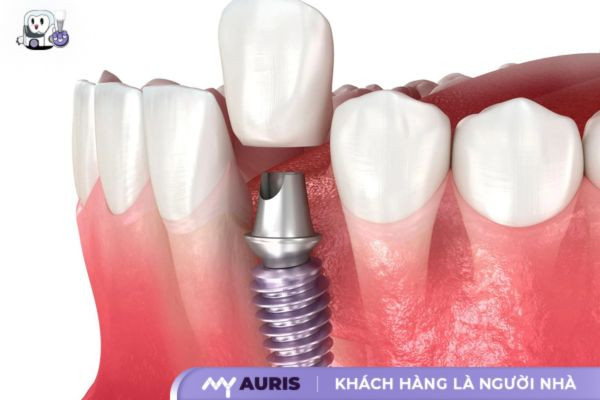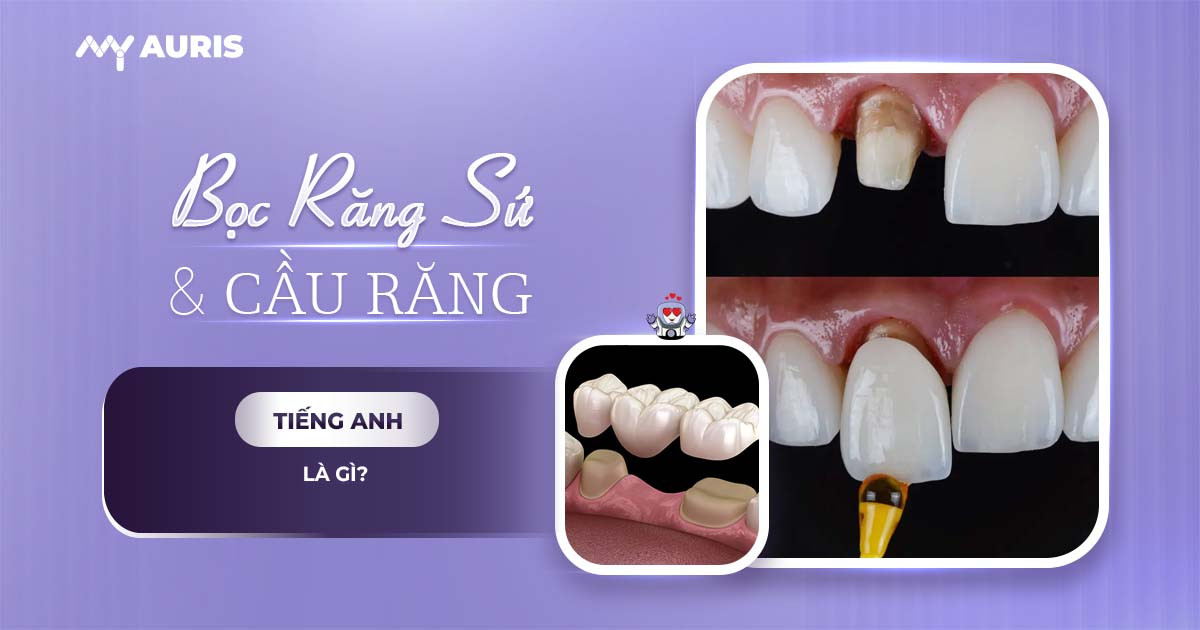Dental crowning is a popular cosmetic dentistry method that helps address various dental issues such as gapped teeth, yellowed teeth, chipped teeth, and other dental imperfections, delivering high effectiveness in improving tooth shape and color. This solution is of interest to many for its ability to restore aesthetics and chewing function.
If you’re wondering what the English term for dental crowning is, this article from My Auris Dental Clinic will help you better understand the meaning of common dental terms like veneers, crowns, and bonding. Additionally, we provide practical dental communication phrases to help dentists and foreign patients easily communicate during consultation and treatment.
What are Dental Crowns in English?
Researching porcelain teeth in English through reputable search engines will help you access diverse information from both domestic and international websites. This is especially useful if you are researching or preparing to undergo a dental crowning procedure at international dental clinics.

In English, the term for porcelain teeth is often referred to as “ceramic tooth” or “porcelain crowns”.
- Porcelain means sứ (ceramic)
- Crowns means vương miện (crown), mão chụp (cap)
→ Porcelain crowns refer to dental prosthetics made from thin ceramic material, often used to restore damaged teeth or replace missing ones.
Some other related terms:
- Metal-ceramic crowns: metal-ceramic teeth – are a type of dental crown combining ceramic and alloy, often applied in difficult cases such as underbite or misaligned teeth.
- Zirconia crowns: zirconia teeth – made from highly durable and aesthetically pleasing zirconia material, very popular nowadays.
The dental crowning method is an effective aesthetic solution that helps fix dental imperfections such as:
- Protruding, underbite, or misaligned teeth
- Gapped, yellowed, or chipped teeth
- Desire to have straight, white teeth
The procedure includes:
Grinding down natural teeth to a specific proportion to create space for the porcelain crown
Fitting the porcelain crown – which can be a metal-ceramic crown or an all-ceramic crown, helping to correct imperfections and enhance dental aesthetics
The procedure is quick, usually requiring only 2 appointments with the dentist, depending on the number of teeth to be crowned.
Compilation of English Vocabulary for Porcelain Teeth
If you are looking for English vocabulary related to porcelain teeth, this article will help you understand important terms commonly used in international dentistry.

What is a Dental Porcelain Bridge in English?
The specialized term for a dental porcelain bridge in English is “porcelain dental bridge” or “porcelain bridge” – a common method used to restore missing tooth spaces.
Popular types of porcelain dental bridges in English include:
Traditional porcelain bridges – uses 2 natural teeth as supporting abutments.
Cantilever bridge – also known as a one-sided bridge, meaning only one crown is attached to an abutment supporting the false bridge.
Adhesive bridge – usually uses special adhesive to fix it to adjacent teeth.
Implant-supported bridge – a porcelain bridge combined with implants, providing stable restoration thanks to implanted titanium posts.

What are Dentures in English?
False teeth in English are called “dentures” or “false teeth”. Common types include: removable plastic dentures, partial dentures, or fixed porcelain teeth.
Yellowed teeth in English
The condition of yellowed teeth in English is called “yellowed teeth” – describing teeth that have turned yellowish or stained due to plaque (also known as tartar), leading to aesthetic loss and potential risk of tooth decay and other oral diseases.
What is ‘Dull/Discolored’ in English?
The word to describe dull or discolored teeth or objects in English is “dull”, referring to a change in color, becoming opaque, grayish, or darkened. This is a common symptom when teeth enamel is damaged or when plaque has accumulated over time.

What is Porcelain Tooth Implantation in English?
In restorative dentistry, porcelain tooth implantation in English is called “implant porcelain teeth” – a technique for fully restoring tooth structure, used to replace permanent teeth lost due to decay or accidents.
Root canal in English
In the field of dentistry, root canal treatment in English is referred to as “root canal” – a procedure to clean and treat the root canal to remove bacteria and preserve the natural tooth.
Jaw in English
The common term for jaw in English is “jaw”, in which:
- Upper jaw: upper jaw or maxilla (used in medicine)
- Lower jaw: lower jaw or mandible
What is Tooth Grinding in English?
The vocabulary word to describe the act of grinding teeth in English is “grinding”, also used to refer to the creaking, gnashing sound when two hard surfaces meet – commonly occurring in the habit of teeth grinding during sleep.
What is Porcelain Bonding/Veneering in English?
In cosmetic dentistry, porcelain bonding in English often uses verbs such as “paste” (to bond with a thick adhesive), “cement” (to permanently attach with dental cement), or “stick” (to adhere).
Compilation of Common English Phrases Used in Dentistry for Dental Crowns
Effective communication between dentists and foreign patients is crucial, especially during procedures like dental crowning. Here are some common English phrases in dentistry to help you easily manage situations during examination and treatment:
- I’d like a check-up – I want a dental check-up.
- Would you like to come through? – Please come into the examination room.
- When did you last visit the dentist? – When was your last dental visit?
- Have you had any problems? – Have you experienced any dental problems?
- I’ve got toothache – I have a toothache.
- I’ve chipped a tooth – I have a chipped tooth.
- I’d like a clean and polish, please – I would like a clean and polish for my teeth.
- Can you open your mouth, please? – Could you please open your mouth?
- A little wider, please – A little wider, please.
- I’m going to give you an x-ray – I will take an x-ray for you.
- You’ve got a bit of decay in this one – This tooth has a bit of decay.
- You need two fillings – You need two fillings.
- I’m going to have to take this tooth out – I will have to extract this tooth.
- Do you want to have a crown fitted? – Do you want to have a dental crown fitted?
- Let me know if you feel any pain – Please let me know if you feel any pain.
Many people wonder: “Why are porcelain crowns more expensive than plastic teeth?”. The reason is that high-grade porcelain crowns like Zirconia or Cercon HT are manufactured using modern CAD/CAM technology, offering high precision and superior aesthetics. Specifically:
- Cercon HT is a popular non-metal porcelain crown type, favored for its desirable aesthetic results, matching the face and current tooth color.
- The price of a Cercon HT porcelain crown ranges around 6 million VND/tooth, commensurate with its durability and lifespan.
- The average lifespan of metal-ceramic crowns is 2-3 years, with a maximum of 5 years, while high-grade ceramic types can last longer with proper care.
After getting porcelain crowns, patients can chew like natural teeth, feeling comfortable, without any bulkiness or discomfort. However, the desired effect will not be achieved if:
- The tooth has a dead pulp, severe intrinsic staining, or antibiotic staining. In such cases, porcelain crowning is the only effective solution.
- If the teeth are too crooked or severely misaligned, the dentist needs to perform the procedure carefully, avoiding excessive grinding that could violate the biological width, and grinding to the correct proportion to ensure the porcelain crown fits naturally and beautifully.
When to Get Dental Crowns and How Much Do They Cost?
Dental crowning is an effective and aesthetic method for restoring oral health, widely used in modern dentistry. However, when to get dental crowns depends on the specific dental condition of each individual and requires assessment and consultation from a dental professional.
Cases where dental crowns are recommended:
- Teeth with decay, pulpitis, or extensive fractures
- Gapped teeth, misaligned teeth, spaced teeth, mildly protruding teeth
- Discolored teeth that cannot be whitened
- Loss of one or multiple teeth, requiring restoration with a dental bridge
For the above conditions, dental crowning not only enhances oral aesthetics but also improves chewing function like natural teeth. This is a worthwhile option if you desire a confident smile and healthy teeth.
The cost of dental crowns varies depending on the material used and the specific dental condition. Currently, the prices of common types of porcelain crowns are as follows:
- Standard metal-ceramic crowns: from 1,000,000 VND/tooth – a lower price, suitable for limited budgets
- Titanium porcelain crowns: mid-range price, stable durability
- All-ceramic crowns: from 4,000,000 – 6,000,000 VND/tooth – offering superior aesthetics and chewing function, with a lifespan of up to 20 years
Depending on your financial situation and dental condition, you can choose from many existing lines of porcelain crown products. The increasing demand for cosmetic dental crowns has also led to the emergence of many new types of porcelain crowns, offering flexible solutions.
Before proceeding, consult with a dental professional to choose the appropriate method and receive personalized advice. This ensures safety, long-term effectiveness, and an optimal experience throughout the dental crowning process.
If you need treatment at an international clinic domestically or while traveling abroad, understanding what “dental crowning” means in English and knowing common dental communication phrases will help you feel more confident when facing dental issues and easily communicate with dental professionals.





